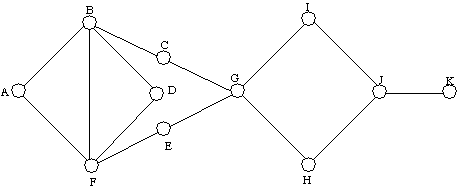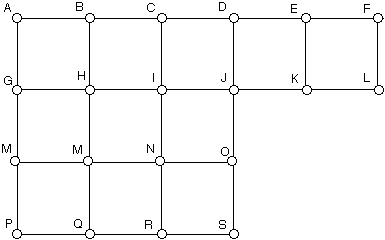Chapter 5 Practice Problems
Part I (Multiple Choice)
 |
Figure 1 |
- Which of the following edges is a bridge of the graph in
Figure 1
- BC
- GH
- IJ
- JK
- None of these
- How many vertices does the graph in Figure 1 have?
- 10
- 12
- 11
- 9
- None of these
- How many edges does the graph in Figure 1 have?
- 10
- 14
- 13
- 12
- None of
these
- The graph in Figure 1 is eulerian (has an eulerian
circuit).
- True
- False
- The graph Figure 1 has an eulerian path.
- True
- False
- Which of the following is not a circuit in the graph in
Figure 1?
- A, B, F, A
- A, B, D, F, A
- A, B, C, D, E, F, A
- G, I, J, H, G
- None of these
- A graph with 7 vertices has an eulerian path but
not an eulerian circuit. The graph must have
- 7 vertices of even degree
- 5 vertices of odd degree and 2 vertices of even
degree
- 2 vertices of odd degree and 5 vertices of even
degree
- 2 vertices of even degree and 4 vertices of odd
degree, and one isolated vertex
- None of the above
- A graph has 8 vertices and 13 edges; the seven vertices have
the following degrees:
2, 5, 4, 2, 3, 5, 2. Find the degree of the
remaining vertex.
- 1
- 2
- 3
- 5
- None of the above
Part II: Show all your work for this part.
- How Does Fleury's algorithm work?
- State, in your own words, Euler's theorems.
- Give at least five applications that Euler's theorem can be used.
- Find an optimal eulerization for the graph shown in Figure 2. Make sure to mark your deadhead edges.
 |
Figure 2 |
- Find, using Fleury's algorithm, an euler circuit for the
eulerized graph of Figure 2 you did in Problem # 12.